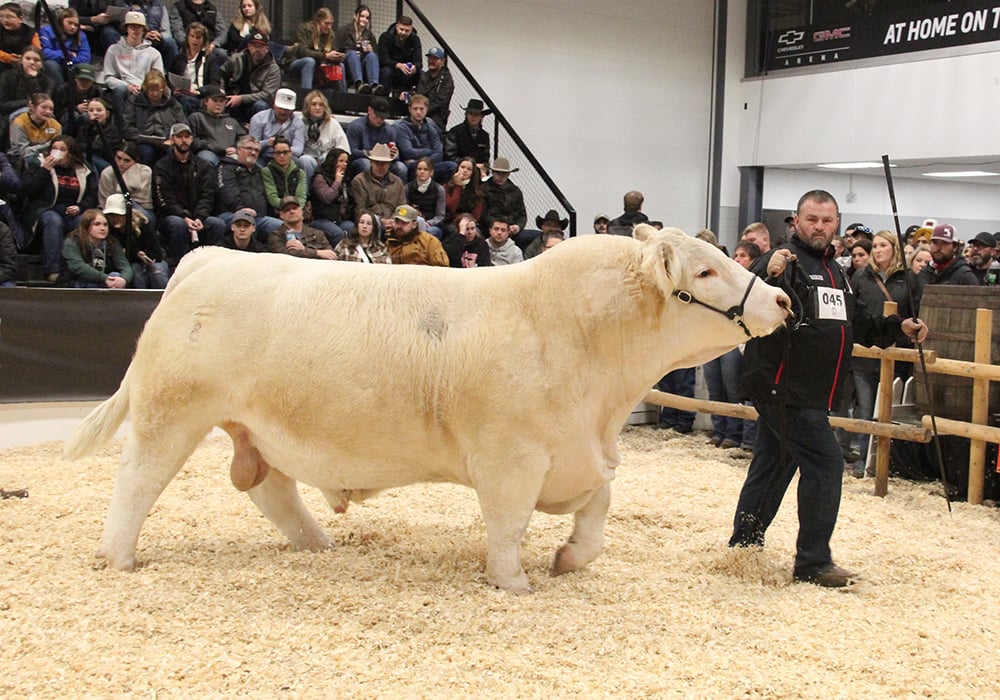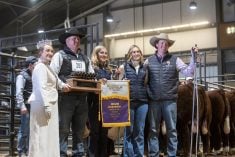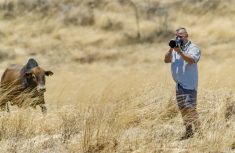There are 100 animals in the ring of Agribition’s Beef Supreme on November 30, consisting of bulls, cows and some calves. The stands are full of people, and even more crowd around the door — almost more than the room can hold. They are all eagerly waiting to see who will win the coveted titles of Supreme Champion bull and female.
Blanchette Ranch has the second bull picked for the top 10. When Tyler leads his Charolais Grand Champion bull into the centre of the ring, he’s grinning. He has one of the top bulls in the whole show when a year ago, he had never shown cattle in a purebred show.
Adding purebreds
Read Also

What to know before you go to Agribition 2025
If you’re attending Agribition 2025, this is the place to find out about tickets, dates and what’s happening this year.
Tyler Blanchette and his family ranch near Vawn, Sask., on what has traditionally been a commercial operation. However, when Tyler’s three children, Bennett, Briar, and Briggs, fell in love with showing cattle in 4-H, he wondered how they could become more competitive. So in the fall of 2023, they decided to start a purebred cattle herd and compete in shows across Western Canada.
“The kids were involved in 4-H and they were looking to become a little bit more competitive, which led us to the Charolais breed. And we sort of took off from there,” Tyler says.
There were also benefits for their business since they exclusively use Charolais bulls on their commercial cattle. They focus on maternal females, without sacrificing performance.
“We’ve tried to select the best animals we could source, and it’s been working out quite well for us so far,” says Tyler.
For Tyler’s daughter, Briar, the past year at the cattle shows they’ve attended has been memorable.
“I do like to be in the ring,” she says.

The purebred herd has created many benefits for the Blanchettes.
“It ties in nicely into what we do on a daily basis, too, on the ranch. It makes a lot of connections,” Tyler’s wife, Kim Blanchette, says.
However, it has been a learning curve. Switching gears from fully commercial to implementing a purebred herd was no simple feat. Tyler says one of the biggest challenges he is anticipating is winter calving with his purebred herd and continuing to calve in the spring with his commercial herd.
It is also a large investment.
“You change your focus from being cost-conscious and from being efficient to ensuring quality. So that’s been a bit of a change for us,” Tyler says.
They also attribute part of their success to the guidance of other purebred producers.
“It’s a very good community. We’ve met a lot of real nice people… I felt that we’ve been given a hand up all the time where people are willing to help guide us to get better and improve our genetics.”
Their experience in the commercial industry has also been helpful, especially with selecting the right animals, and in marketing and understanding how the industry works.
“Obviously, some of the connections that we had made prior to buying purebreds have hugely benefited us now,” Tyler says. “Some of them have guided us with where to look for animals or even sold us some animals. And so it would be very hard to be successful without some understanding of the whole industry.”
A ‘whirlwind’ first year
In their first year, the Blanchettes have attended 26 different cattle shows.
“It’s been a whirlwind, but it’s been fantastic. We’ve had quite a bit of success, and so that sort of motivates you to keep going,” Tyler says.
That may seem like a lot to most people, but Tyler says when they commit to something, they go all in.
“We’re not really halfway people. We felt like if we were going to do it, we wanted to be successful. We’re extremely competitive. So that’s the start of it, and it’s just like anything: if you don’t dedicate yourself to it, then you’ll be far less successful.”
They have had many successes in their first year. At Agribition, they finished first in youth team grooming for the intermediate and junior classes, and second in the senior class. In the First Lady Classic, their cow made it into the top five. They also had a bull in the top 10 of the Beef Supreme.
Tyler says he is proud of their accomplishments.
“The grooming and the showmanship at Agribition would definitely be at the top. I think the toughest competition in all of Canada is here for sure.”
Their success at cattle shows was unexpected in their first year both as purebred producers and competitors. Tyler says they are grateful for the advice and guidance other producers at the shows have given to their children, which has helped with their continued success.
“We’ve got connected with some very good mentors that have helped us out at the shows and at home as well, to help guide the kids and make sure the cattle are ready, and just kind of keep us on the right track. And so that’s really helped with our success and our kids learning.”
Though their children love being in the ring and showing cattle, attending all these cattle shows has shown them other things they enjoy, as well.
“My favourite part is probably doing it as a family because you get to spend more time with each other. And also probably showing (cattle),” Briar says.
Her older brother, Bennett, enjoys the atmosphere of these cattle shows.
“Mine’s meeting the whole group of new people,” Bennett says when asked about his favourite part about cattle shows.
Future
Though the Blanchettes have enjoyed their year attending cattle shows, going to 26 shows won’t be feasible every year. Now that they have the experience, they know which shows they want to attend.
“We’re quite a bit more informed than we were before we went, and so we might select the ones that we enjoyed the most and kind of suit our schedule, but I’m pretty confident we will continue showing for sure,” Tyler says.
For their purebred herd, 2025 will be their first year of a purebred calf crop after implanting embryos. After that, they will continue to pursue their genetics.
“That’s one of the focuses, we’re going to utilize embryo transplant and artificial insemination to try and improve and propagate the front-end genetics.”

















